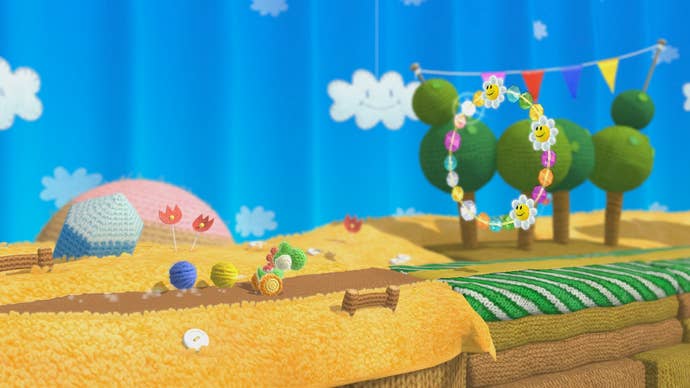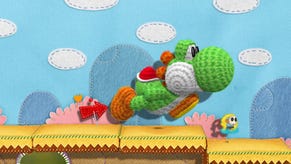Yoshi's Woolly World Wii U Review: Pull the String
Good-Feel's take on Nintendo's dinosaur pal might be cut from a familiar cloth, but its abundance of charm makes up for a lack of new ideas.
This article first appeared on USgamer, a partner publication of VG247. Some content, such as this article, has been migrated to VG247 for posterity after USgamer's closure - but it has not been edited or further vetted by the VG247 team.
Sequelizing 1995's Yoshi's Island stands as an incredibly tall order for any developer. After all, we're talking about the 2D platformer that set out to do basically everything—and kinda did.
Even though Nintendo stubbornly refuses to release the original Super Nintendo version on any of their Virtual Console services, Yoshi's Island remains one of their finest productions, simply due to the circumstances surrounding its development. With the advent of the polygon age seemingly dooming sprite-based 2D graphics to an untimely demise, Yoshi's Island came into being as the logical conclusion of the traditional side-scrolling Mario series: one directed by the man who essentially co-created the genre. Though this might not have been the developers' explicit intent, Yoshi's Island acted as the be-all and end-all of 2D Nintendo platformers, one that would close the door on a solid decade of development. (Thankfully, history shook out differently than expected.)

Keeping this in mind, it's hard to blame any sequel for sticking too close to the Yoshi's Island formula. Any follow-up is doomed to stand in the shadow of this legendary predecessor, so why not embrace it? And Yoshi's Wooly World does exactly this. In terms of pure mechanics, outside of a few notable additions, developer Good-Feel's take on Yoshi doesn't differ all that much from the 1995 original: Yoshi swallows enemies, converts them into handy projectiles, and explores large levels typically focused on a central set piece. If an idea existed in the original Yoshi's Island, it's most likely represented here, albeit in a form slightly different from the childish—though wonderful—doodles that defined Super Nintendo game.
The biggest change—indicated by the title—can be found in the way Wooly World chooses to express its interpretation of Yoshi's Island. Essentially, the entire production is wrapped in the cozy, fuzzy world of arts and crafts: Yoshi and the surrounding cast are essentially sentient bundles of yarn and/or fabric, living in a world made of the same. While the whole "Wooly World" concept mainly exists for the sake of visual flair, it also factors into the gameplay by allowing Yoshi to unravel various objects that bear a loose thread—often revealing hidden treasures. This element makes the large, exploration-focused levels even richer with secrets, as every seemingly solid chunk of the environment could be hiding some of the many, many collectibles found within Yoshi's Wooly World.
And it's these collectibles that implicitly create two different ways to play. You could choose to ignore them entirely—or not go out of your way to 100% every level—and still experience a moderately challenging platformer which can be bumped down to a "Mellow" difficulty level for those not accustomed to this type of game. Going for a completionist run, however, stands as a challenge for platforming experts—ones with plenty of patience. Since Yoshi's Wooly World trafficks in three different kinds of collectibles, it offers plenty of reasons for meticulous players to scour every inch for that last daisy, stamp patch, or ball of wool—five of which unlock a different and adorable skin for Yoshi to don. While many of these items can be found in the wild, some are hiding behind organic mini-challenges: If you, say, stomp a switch and see a mass of floating beads appear in front of you, nabbing them all before they vanish will likely net you something nice.
Unfortunately, Yoshi's Wooly World isn't very friendly to anyone with the completionist's mindset. Those organic challenges seamlessly baked into the levels don't let you know they're hiding a collectible until you actually complete them successfully, and it's incredibly easy to simply pass one of these items by with no way to reach them again without restarting the level. Wooly World also forgets about any collectibles you nab before hitting a checkpoint, so expertly completing some challenge and then immediately plummeting into a pit means you'll have to roll up your sleeves and do it all over again. So if you're devoted to the completionist cause, expect Wooly World to essentially quintuple in size as you play levels multiple times to find those precious remaining collectibles—in my time with the game, I only nabbed them all in one go exactly once.

Again, you don't necessarily have to play Wooly World this way to have fun. I started with the intent to 100% every level, then soon realized how much effort this would take and simply played every level to reach the end. And even if many of these levels crib from Yoshi's Island, each one manages to present a new idea, or wrap an old one in some new packaging. Wooly World even offers a variety of perks—purchased with the game's equivalent of coins—to help out with some particularly tricky levels. If you'd like to make it so those traditional bottomless pits don't kill you outright, that's entirely possible—so long as you can foot the bill.
Wooly World doesn't aspire to be much more than a warmer, fuzzier take on the original Yoshi's Island, which is probably for the best. That statement isn't a comment on Good-Feel's development acumen; rather, it's a testament to their understanding of good game design. While I'd love for Nintendo EAD to give us a true sequel to this 1995 classic rather than farming it out to another party, the fact remains that Yoshi's Island is a stellar game worthy of reinterpretation. If, like me, you experienced the original in the mid-'90s, the ideas presented in Wooly World may not seem all that novel 20 years later. Even if they're warmed over, that doesn't mean this recycling is unwelcome: If anything, Wooly World serves as an excellent reminder that great games can survive decades of progress.
InterfaceIf you've played Yoshi's Island, you'll find that things aren't too different 20 years later—and that's a good thing.
Lasting AppealFor most, Wooly World will last around eight hours. But completionists with an abundance of patience can easily quadruple this number digging up the game's many secrets.
SoundThe mellow soundtrack might not get stuck in your head, but it still provides the perfect accompaniment to this gentle adventure.
VisualsWooly World absolutely commits to its hand-crafted art style. And just when you think it's explored every possible take on this idea, there's always a new surprise around the corner.
ConclusionWhile Wooly World is mostly Yoshi's Island in a fuzzier package, that's not necessarily a bad thing. Its arts and crafts makeover may be mostly superficial, but by working with the parts of one of the world's greatest platformers, developer Good-Feel makes their recycling worthwhile.












